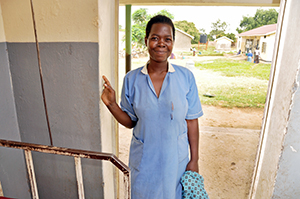
Two Projects Working Together to Strengthen the Health Workforce in Uganda
- Login to post comments
-

How can a global project and a country-specific project work together to strengthen the health workforce and increase access to quality care? What about in Uganda, where there are only 14 doctors, nurses, and midwives for every 10,000 people?
The CapacityPlus global project and the Uganda Capacity Program are both funded by USAID and led by IntraHealth International. CapacityPlus has worked in over 20 countries to address the health workforce shortage, and offers tools that can be adapted for any country. The Uganda Capacity Program builds the capacity of local Ugandan institutions—like ministries, professional health councils, and universities—to plan for, develop, and strengthen the management of health workers.
In Uganda, CapacityPlus pursued activities linked with those of the Uganda Capacity Program to propel national progress as well as to create and test tools that could be generalized for use in other countries. The two projects hold monthly meetings to report progress, share knowledge, and provide support.
Using data to get more health workers in rural locations
Dr. Vincent Oketcho, IntraHealth country director and chief of party for the Uganda Capacity Program, points to a retention survey as one way the projects collaborated to get more health workers to serve in rural locations, where they're needed most. “That was a study done with support from the global project and we’ve used it to inform decisions in attracting and retaining health workers in positions that are sometimes considered difficult,” he notes.
Working with the Ministry of Health,  the two projects conducted the survey to determine the motivational preferences for doctors, nurses, and laboratory technicians to accept and keep posts in remote areas. The study, involving 158 health workers and 544 students, informed the development of CapacityPlus’s Rapid Retention Survey Toolkit and iHRIS Retain, a tool to determine the cost of retention strategies that was also tested in Uganda. The Uganda Capacity Program then used the study results and costing data, along with other health workforce information, to support the Ministry of Health’s advocacy efforts. These efforts led to increased funding for hiring 8,000 new health workers and doubling medical doctors’ salaries.
the two projects conducted the survey to determine the motivational preferences for doctors, nurses, and laboratory technicians to accept and keep posts in remote areas. The study, involving 158 health workers and 544 students, informed the development of CapacityPlus’s Rapid Retention Survey Toolkit and iHRIS Retain, a tool to determine the cost of retention strategies that was also tested in Uganda. The Uganda Capacity Program then used the study results and costing data, along with other health workforce information, to support the Ministry of Health’s advocacy efforts. These efforts led to increased funding for hiring 8,000 new health workers and doubling medical doctors’ salaries.
In addition, CapacityPlus led a health worker compensation study for doctors, nurses, midwives, pharmacists, and laboratory technicians working in the public sector and in faith-based organizations. “One of the things we have struggled with is how much should we pay [health workers],” says Dr. Oketcho. “So the wage study by the global project will give us information for consideration for wage requirements that would be considered adequate.”
Findings from the retention survey, iHRIS Retain, and health workforce compensation study will provide the Ministry of Health, other ministries, faith-based organizations, and development partners with evidence to improve health worker retention. CapacityPlus is now helping the Uganda Capacity Program in its efforts to stimulate health workforce stakeholders to implement a national health workforce retention strategy.
Building sustainability for the national human resources information system
A few years ago, Uganda’s health workforce leaders did not know how many health workers were in the country, where they were located, or if they were properly qualified. Now, Uganda is using an electronic human resources for health information system, known as HRHIS, to track and manage health workers. Dr. Oketcho explains, “The global project worked to develop the iHRIS software, and we have worked very closely with the global project and other staff in developing the country HRHIS. So, we have worked collaboratively and in a matter that would complement each other, and both of us realized our objectives.”
The Uganda Capacity Program customized the iHRIS software for Uganda’s needs. It’s now being used by the Ministry of Health, four professional health councils, 13 regional referral hospitals, and 74 districts. CapacityPlus, in close coordination with the Uganda Capacity Program, focused on strengthening the Ministry of Health’s capacity to use data from the HRHIS to inform health workforce decision-making. Using the project’s guidelines for stakeholder leadership groups, CapacityPlus assisted a Ministry of Health task force in developing plans for ensuring country ownership and improving service delivery through strengthened health workforce management.
The two projects are now working together to transition HRHIS technical support to the Ministry. Dr. Oketcho concludes, “IntraHealth’s main role is capacity-building for local counterparts—the Ministry of Health, district and facility managers, Ministry of Public Service, and Ministry of Education—shoulder-to-shoulder with emphasis on technology transfer, providing technological assistance, and facilitating them to move forward.” In short, he says, the focus is squarely on building local capacity for sustainability, “so that by the end of the project, when we leave, our counterparts will still be able to go on with the work that we have been doing.”
The Uganda Capacity Program is funded by USAID and led by IntraHealth International. IntraHealth is the lead partner in the CapacityPlus global project, also funded by USAID.
Help CapacityPlus spread the word about strengthening the health workforce. Follow us on Twitter and like us on Facebook.
Related items:
Photo by Carol Bales (Health worker in Dokolo District, Uganda)


